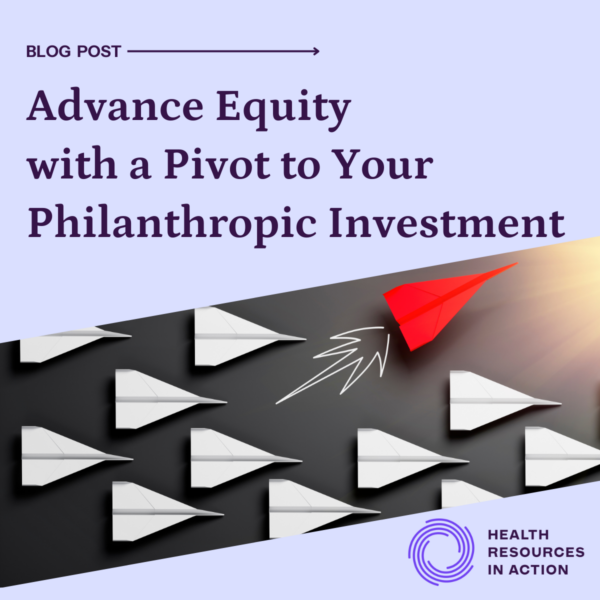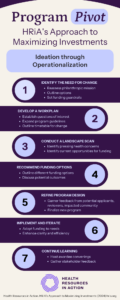
Philanthropic organizations might view shifting investment strategies as risky and potentially resource intensive. Is it possible for organizations to mitigate risk and build confidence in new strategies? Can organizations respond to changes in the field while staying true to their mission?
We believe that it is not only possible but imperative to address emergent needs in the field for an organization to remain relevant and compelling. To do this, philanthropic organizations must creatively shift their investment strategies at pivotal moments. HRiA’s Pivot framework (Figure 1) offers guidance on how to realize these changes while remaining true to the organization’s purpose. Using our work with a long-time client, we illustrate how to implement investment shifting activities.
The Jeffress Trust Pivot
The Thomas F. and Kate Miller Memorial Trust (herein the Trust) has worked with HRiA since 2013. The Trust provides funding to Virginia-based scientists conducting research in bioinformatics, astrophysics, drug development, and material science to benefit residents of Virginia.
Below is a synopsis of how the Pivot framework informed our work with the Trust.
- Step 1: Identify the need for change. In 2019, the Trust engaged HRiA to explore opportunities to shift investments. To ensure the revised program remained tied to the mission, the Trust and HRiA established guardrails on potential future investment options. By limiting potential investments to those that would support work done by Virginia-based organizations for the benefit of Virginia residents, the partners guaranteed that the new program would align with the Trust’s mission.
- Step 2: Develop a workplan. Once the need was stated, our team and the Trust developed a workplan. Together, we set a timeline to address questions of interest, expand current program guidelines, and design a new funding opportunity.
-

Figure 1: Program Pivot – HRiA’s Approach to Maximizing Investments.
Step 3: Conduct a landscape scan. To create a high-impact, targeted investment strategy, our team needed to better understand Virginia’s most pressing health concerns and funding landscape. Our landscape scan aggregated data from secondary sources, funders, and key informant interviews from community-serving organizations and other stakeholders.
- Step 4: Recommend funding options. Guided by the scan data, HRiA and the Trust discussed various funding approaches and potential outcomes. We confirmed the program should maintain its commitment to funding state-specific projects as decided on/informed by Virginia residents. This action maintains the Trust’s mission of benefitting the people of Virginia and research in chemical, medical or other scientific fields. The data also illuminated the need to support research that centered community voice, facilitated collaboration among organizations, and built capacity in topics related to health equity. The Trust addressed these needs in the program’s funding design.
- Step 5: Refine program design. HRiA requested feedback on initial drafts of the funding design from various individuals and organizations. This feedback helped refine the program and enhance the Trust’s confidence in their decision to pivot to a new funding area. Also, it deepened the relationship between the Trust and Virginia-based organizations engaged in health equity work.
- Step 6: Implement and iterate. The Trust and HRiA successfully built a mission-aligned program, embedded with principles that empower those affected by funding. The program announced its inaugural cohort of awardees in 2022. Positive feedback flowed in from stakeholders across the state. The Trust and HRiA frequently seek feedback to inform future iterations of the program.
- Step 7: Continue learning. One of the Trust’s key listening methods is convening awardees to discuss projects, lessons learned, and opportunities to augment the impact of their work. The Trust is excited to support continued learning across this network of organizations to further advance health equity in Virginia.
A Final Note
The Trust will soon announce its third cohort of recipients. We invite you to read more about the work of current awardees and follow their progress.
HRiA seeks to address the root causes of health across all its funding mechanisms. Contact our experienced and trusted team members to learn how we can support you.

